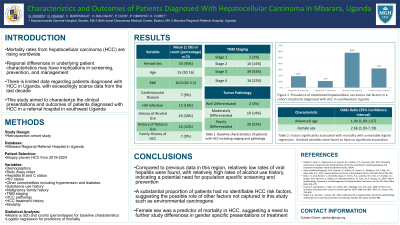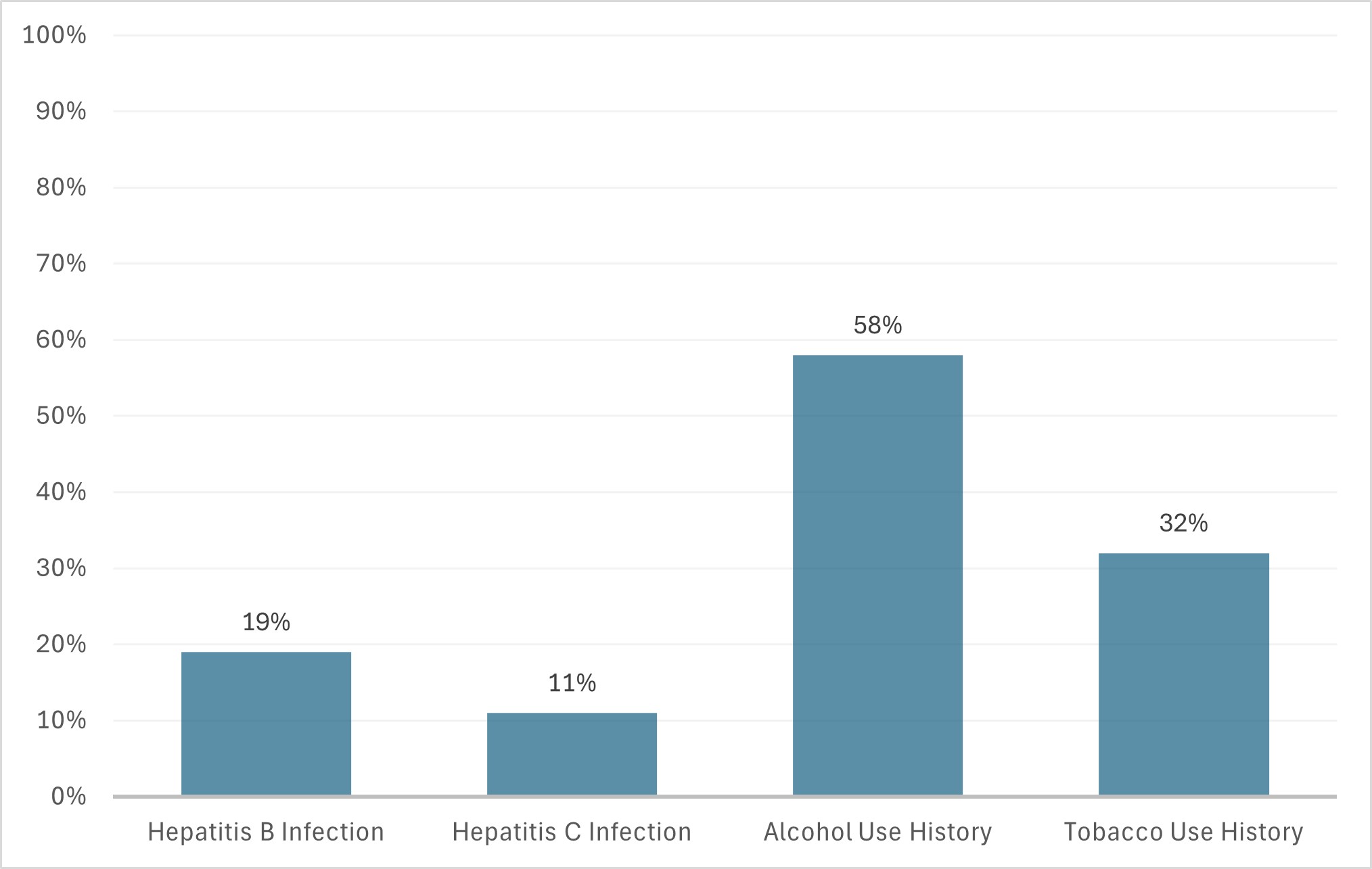Monday Poster Session
Category: Liver
P2923 - Characteristics and Outcomes of Patients Diagnosed With Hepatocellular Carcinoma in Mbarara, Uganda
Monday, October 28, 2024
10:30 AM - 4:00 PM ET
Location: Exhibit Hall E

Has Audio
- QD
Quinten Dicken, MD
Massachusetts General Hospital, Harvard Medical School
Boston, MA
Presenting Author(s)
Quinten Dicken, MD1, Dora C. Huang, MD2, Chantal Barksdale, MD1, Oluwafemi Balogun, MBBS, MPH1, Peter Olds, MD, MPH1, Paul Stephen Obwoya, MBChB3, Kathleen E. Corey, MD1
1Massachusetts General Hospital, Harvard Medical School, Boston, MA; 2Beth Israel Deaconess Medical Center, Harvard Medical School, Boston, MA; 3Mbarara University of Science and Technology, Mbarara, Mbarara, Uganda
Introduction: Mortality rates from hepatocellular carcinoma (HCC) are rising worldwide, and regional differences in underlying patient characteristics likely carry implications in screening, prevention, and management. However, there is limited data regarding patients diagnosed with HCC in Uganda, particularly from the last decade. This study aims to characterize the clinical presentations and outcomes of patients diagnosed with HCC in a referral hospital in southwest Uganda.
Methods: We retrospectively identified patients at Mbarara Regional Referral Hospital from 2019 to 2024 with biopsy-proven HCC. We collected data on demographics, clinical presentation, treatment history, and outcomes. Baseline characteristics were summarized with means (± standard deviation (SD)) for continuous variables and counts (percentages) for categorical variables. Univariable and multivariable logistic regression were performed to identify predictors of mortality.
Results: We identified 74 patients with biopsy-proven HCC, with 33 (45%) of female sex. Mean age was 55 years (± SD 16). Comorbid conditions included 12 (16%) with HIV, 14 (19%) with hepatitis B, and 8 (11%) with hepatitis C. History of alcohol use and tobacco use were found in 43 (58%) and 24 (32%) patients, respectively (Figure 1). Tumor-Node-Metastasis (TNM) staging from imaging near time of diagnosis showed 2 (3%) at stage I, 10 (14%) at stage II, 39 (53%) at stage III, and 16 (22%) at stage IV. Pathology showed 13 (18%) well-differentiated, 26 (35%) moderately-differentiated, and 17 (23%) poorly-differentiated tumors. Mortality occurred in 42 (57%) patients prior to final follow up. On univariable analysis, age and female sex were significant predictors of mortality, and multivariable analysis showed age as a significant predictor (Table 1).
Discussion: In this cohort of patients diagnosed with HCC in southwestern Uganda, we found relatively low rates of viral hepatitis and high rates of alcohol use compared to previous literature. A substantial proportion of patients were not found to have established HCC risk factors, which may indicate factors not captured in this study, such as environmental exposures. Our study identified female sex as a predictor of mortality, suggesting potential sex-specific differences in presentation or treatment in this region. These findings suggest unique predominating risk factors in the region, which, with future work, can guide population-specific screening and prevention efforts.

Note: The table for this abstract can be viewed in the ePoster Gallery section of the ACG 2024 ePoster Site or in The American Journal of Gastroenterology's abstract supplement issue, both of which will be available starting October 27, 2024.
Disclosures:
Quinten Dicken, MD1, Dora C. Huang, MD2, Chantal Barksdale, MD1, Oluwafemi Balogun, MBBS, MPH1, Peter Olds, MD, MPH1, Paul Stephen Obwoya, MBChB3, Kathleen E. Corey, MD1. P2923 - Characteristics and Outcomes of Patients Diagnosed With Hepatocellular Carcinoma in Mbarara, Uganda, ACG 2024 Annual Scientific Meeting Abstracts. Philadelphia, PA: American College of Gastroenterology.
1Massachusetts General Hospital, Harvard Medical School, Boston, MA; 2Beth Israel Deaconess Medical Center, Harvard Medical School, Boston, MA; 3Mbarara University of Science and Technology, Mbarara, Mbarara, Uganda
Introduction: Mortality rates from hepatocellular carcinoma (HCC) are rising worldwide, and regional differences in underlying patient characteristics likely carry implications in screening, prevention, and management. However, there is limited data regarding patients diagnosed with HCC in Uganda, particularly from the last decade. This study aims to characterize the clinical presentations and outcomes of patients diagnosed with HCC in a referral hospital in southwest Uganda.
Methods: We retrospectively identified patients at Mbarara Regional Referral Hospital from 2019 to 2024 with biopsy-proven HCC. We collected data on demographics, clinical presentation, treatment history, and outcomes. Baseline characteristics were summarized with means (± standard deviation (SD)) for continuous variables and counts (percentages) for categorical variables. Univariable and multivariable logistic regression were performed to identify predictors of mortality.
Results: We identified 74 patients with biopsy-proven HCC, with 33 (45%) of female sex. Mean age was 55 years (± SD 16). Comorbid conditions included 12 (16%) with HIV, 14 (19%) with hepatitis B, and 8 (11%) with hepatitis C. History of alcohol use and tobacco use were found in 43 (58%) and 24 (32%) patients, respectively (Figure 1). Tumor-Node-Metastasis (TNM) staging from imaging near time of diagnosis showed 2 (3%) at stage I, 10 (14%) at stage II, 39 (53%) at stage III, and 16 (22%) at stage IV. Pathology showed 13 (18%) well-differentiated, 26 (35%) moderately-differentiated, and 17 (23%) poorly-differentiated tumors. Mortality occurred in 42 (57%) patients prior to final follow up. On univariable analysis, age and female sex were significant predictors of mortality, and multivariable analysis showed age as a significant predictor (Table 1).
Discussion: In this cohort of patients diagnosed with HCC in southwestern Uganda, we found relatively low rates of viral hepatitis and high rates of alcohol use compared to previous literature. A substantial proportion of patients were not found to have established HCC risk factors, which may indicate factors not captured in this study, such as environmental exposures. Our study identified female sex as a predictor of mortality, suggesting potential sex-specific differences in presentation or treatment in this region. These findings suggest unique predominating risk factors in the region, which, with future work, can guide population-specific screening and prevention efforts.

Figure: Prevalence of established hepatocellular carcinoma risk factors in a cohort of patients diagnosed with HCC in southwestern Uganda
Note: The table for this abstract can be viewed in the ePoster Gallery section of the ACG 2024 ePoster Site or in The American Journal of Gastroenterology's abstract supplement issue, both of which will be available starting October 27, 2024.
Disclosures:
Quinten Dicken indicated no relevant financial relationships.
Dora Huang indicated no relevant financial relationships.
Chantal Barksdale indicated no relevant financial relationships.
Oluwafemi Balogun indicated no relevant financial relationships.
Peter Olds indicated no relevant financial relationships.
Paul Stephen Obwoya indicated no relevant financial relationships.
Kathleen Corey: Intercept – Advisory Committee/Board Member. Medscape – Advisory Committee/Board Member. Sagimet – Advisory Committee/Board Member.
Quinten Dicken, MD1, Dora C. Huang, MD2, Chantal Barksdale, MD1, Oluwafemi Balogun, MBBS, MPH1, Peter Olds, MD, MPH1, Paul Stephen Obwoya, MBChB3, Kathleen E. Corey, MD1. P2923 - Characteristics and Outcomes of Patients Diagnosed With Hepatocellular Carcinoma in Mbarara, Uganda, ACG 2024 Annual Scientific Meeting Abstracts. Philadelphia, PA: American College of Gastroenterology.

